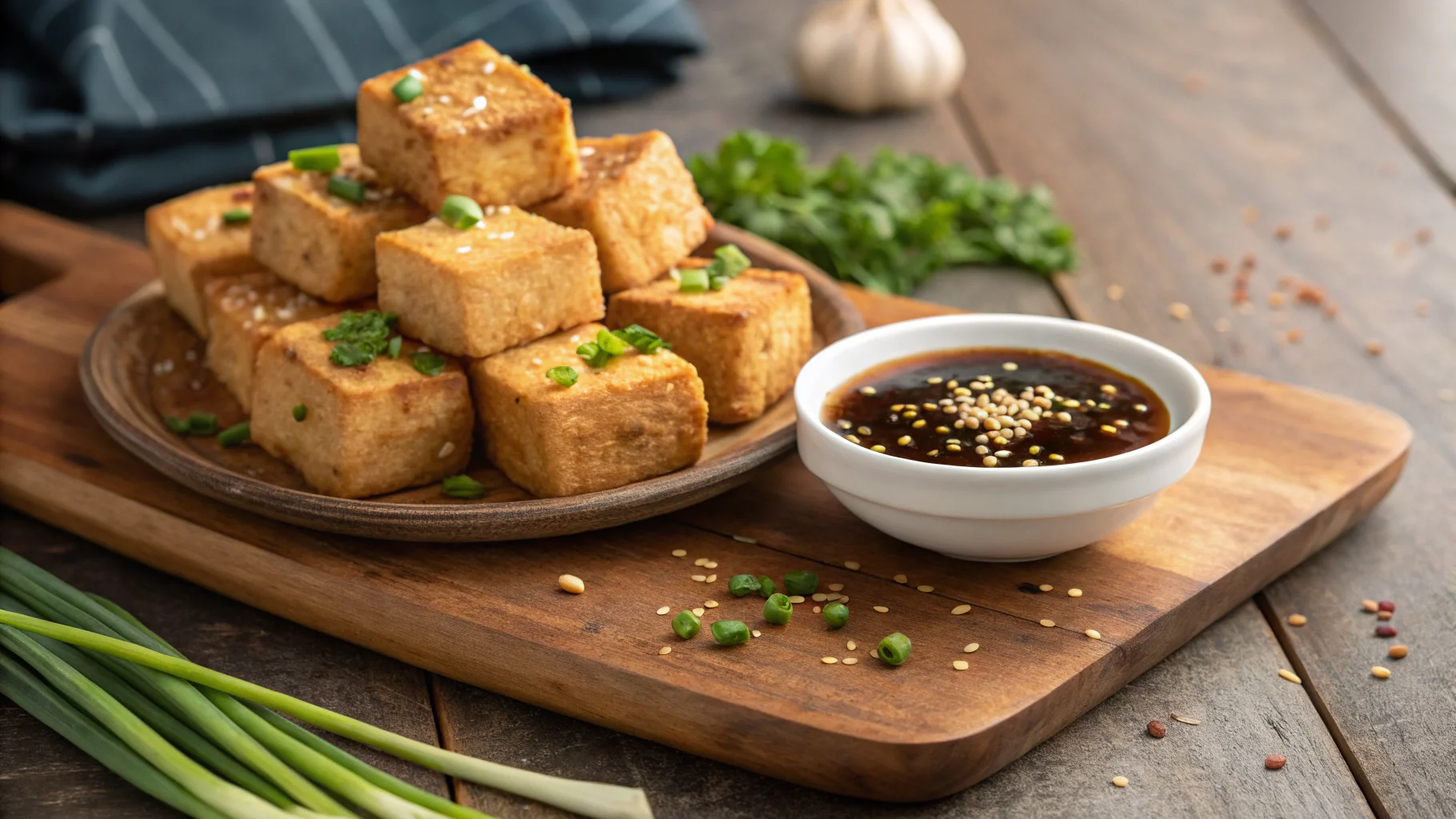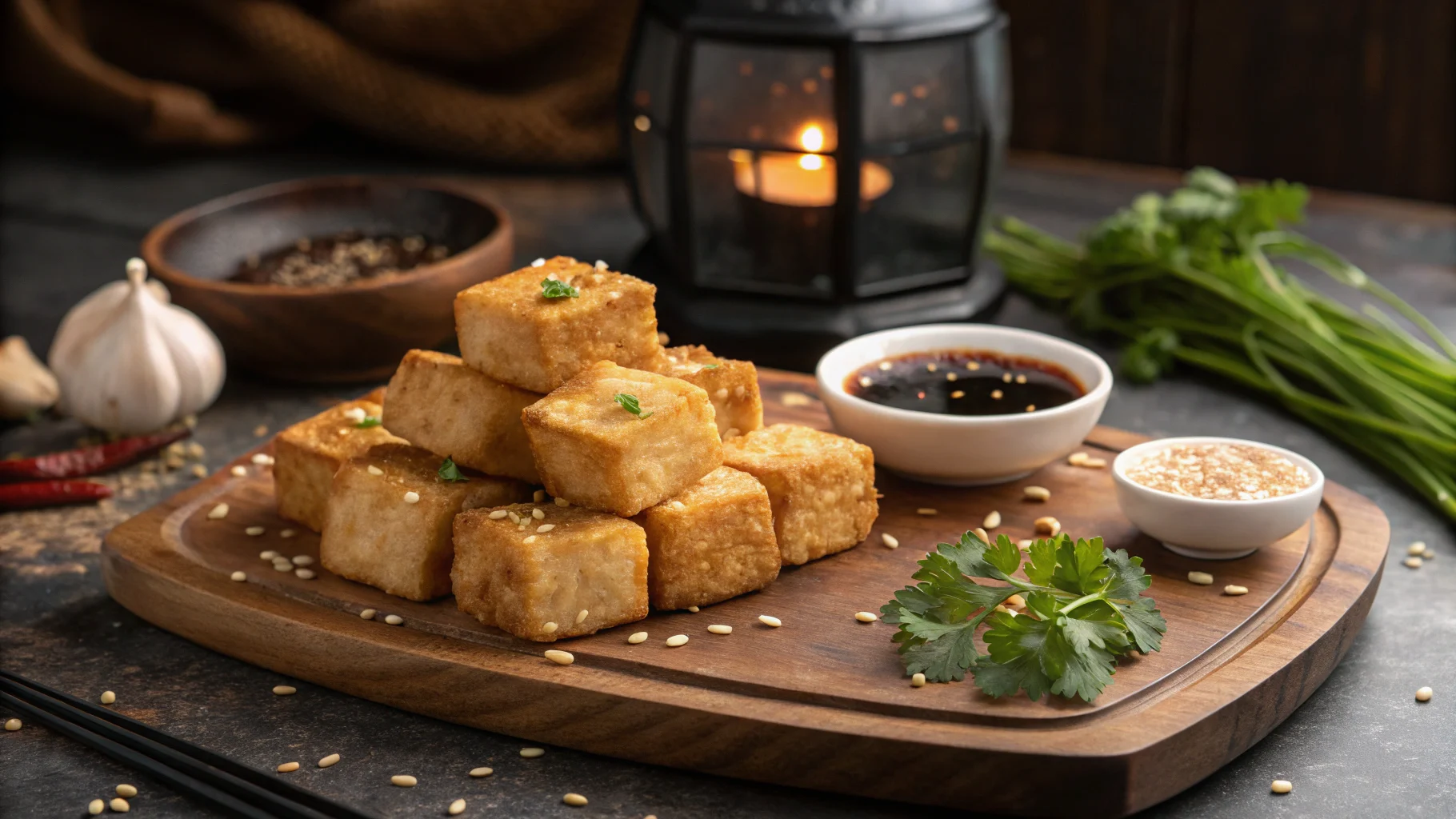Picture yourself wandering through Taipei’s vibrant Shilin Night Market at midnight. Steam rises from countless food stalls, neon lights flicker overhead, and then—BAM—a distinctive aroma stops you dead in your tracks. Your nose wrinkles, your eyes water slightly, yet you notice locals queuing eagerly at a particular vendor. They’re all after the same golden, crispy treasure: authentic Taiwanese stinky tofu.
Your first encounter with this legendary delicacy might trigger confusion, curiosity, or even mild panic. But here’s the truth that countless food adventurers discover: beneath that intimidating exterior lies one of Asia’s most beloved comfort foods. Today, you’ll learn to recreate this extraordinary dish in your own kitchen, complete with the perfect dipping sauce, all within 30 minutes.
What Makes Taiwanese Stinky Tofu So Special?
The Cultural Heart of Taiwan’s Street Food Scene
Stinky tofu represents far more than fermented soybeans. This culinary icon emerged during the Qing Dynasty, evolving from necessity into beloved tradition. Street vendors across Taiwan have perfected their own secret recipes, passing techniques through generations like precious family heirlooms.
When you bite into properly prepared stinky tofu, you’re experiencing centuries of culinary evolution. The contrast between its pungent aroma and surprisingly mild, complex flavor creates an unforgettable sensory experience that transforms skeptics into devoted enthusiasts.
Understanding the Fermentation Magic
The distinctive character of stinky tofu comes from specialized bacterial fermentation. Fresh tofu soaks in carefully aged brine containing various vegetables, dried shrimp, and beneficial bacteria. This process, which can take anywhere from several days to months, develops the characteristic funky aroma while creating layers of umami depth.
Unlike Western fermented foods, stinky tofu fermentation occurs under specific conditions that promote particular bacterial strains. These microorganisms break down proteins into amino acids, creating the complex flavor profile that makes this dish so addictive.
Essential Ingredients for Your Taiwanese Stinky Tofu Recipe with Dipping Sauce
Main Recipe Components
| Stinky Tofu Ingredients | Quantity | Essential Notes |
|---|---|---|
| Fresh firm tofu | 1 lb (450g) | Must be well-drained |
| Stinky tofu brine | 2 cups | Available at Asian markets |
| Vegetable oil | 3 cups | For deep frying |
| Cornstarch | 1/4 cup | Creates crispy coating |
Signature Dipping Sauce Elements
| Sauce Ingredients | Quantity | Flavor Impact |
|---|---|---|
| Premium soy sauce | 3 tbsp | Provides umami base |
| Rice vinegar | 2 tbsp | Adds bright acidity |
| Chili oil with sediment | 1 tbsp | Heat and texture |
| Fresh garlic, minced | 2 cloves | Aromatic punch |
| Green onions, chopped | 2 stalks | Fresh contrast |
| Sesame oil | 1 tsp | Nutty finish |
| Sugar | 1/2 tsp | Balances flavors |
Sourcing Authentic Ingredients
Finding quality stinky tofu brine marks the difference between authentic results and disappointing imitations. Asian grocery chains like H Mart, 99 Ranch Market, or local Taiwanese specialty stores typically stock several brands. Online retailers offer convenient alternatives, though shipping costs may vary.
When selecting brine, examine the ingredient list carefully. Traditional versions contain fermented vegetables, aged tofu scraps, and sometimes dried seafood. Avoid products with excessive preservatives or artificial additives, as these compromise the authentic fermentation flavors.
Step-by-Step Taiwanese Stinky Tofu Recipe (30 Minutes)
Preparation Phase (10 Minutes)
Tofu Preparation Technique

Begin by draining your firm tofu thoroughly. Place the block between clean kitchen towels and gently press for five minutes, removing excess moisture that would otherwise interfere with proper frying. Cut the drained tofu into uniform 2-inch cubes—this size ensures even cooking while maintaining structural integrity.
Submerge your tofu cubes in stinky tofu brine for at least 15 minutes. While traditional preparation involves overnight marination, this quick method still imparts significant flavor. The brine penetrates the tofu’s surface, creating that distinctive taste you’re seeking.
Just before frying, lightly dust each piece with cornstarch. This coating transforms into a delightfully crispy shell during cooking, providing textural contrast against the silky interior.
Crafting the Perfect Dipping Sauce
Combine soy sauce, rice vinegar, and sesame oil in a small bowl, whisking until well integrated. Add minced garlic—fresh always outperforms dried for this application. Incorporate chopped green onions, reserving some for final garnish.
Gradually add chili oil, tasting as you go. Different brands vary significantly in heat levels, so start conservatively. The sugar seems minimal but serves a crucial role, mellowing the vinegar’s sharpness while enhancing the overall flavor harmony.
Cooking Phase (15 Minutes)
Achieving Perfect Frying Results
Heat your oil to exactly 350°F (175°C) using a reliable thermometer. This temperature proves critical—too low produces greasy, soggy results, while excessive heat burns the exterior before the interior heats properly.
Working in small batches prevents temperature drops that compromise texture. Carefully lower 3-4 pieces into the hot oil, maintaining space between each cube. The tofu should sizzle immediately upon contact, indicating proper oil temperature.
Fry for 3-4 minutes until the exterior turns golden brown and the initial vigorous bubbling subsides. This visual cue indicates moisture has largely evaporated, creating the desired crispy shell.
Alternative Cooking Methods
Not everyone owns a deep fryer or feels comfortable with large amounts of hot oil. Pan-frying offers an excellent alternative, using just enough oil to cover the tofu halfway. Turn pieces carefully to ensure even browning on all sides.
Air fryer enthusiasts can achieve similar results at 380°F for 8-10 minutes, though the texture differs slightly from traditional deep-frying. Oven-baking at 425°F for 20-25 minutes works for health-conscious cooks, though you’ll sacrifice some authenticity for reduced oil consumption.
Assembly and Presentation (5 Minutes)
Drain fried tofu briefly on paper towels before plating. Arrange pieces on your serving dish while still hot—temperature matters significantly for optimal enjoyment. Drizzle the prepared dipping sauce around the tofu or serve it in a separate small bowl for individual dipping.
Garnish with reserved green onions and perhaps a sprinkle of sesame seeds for visual appeal. Traditional Taiwanese presentation keeps things simple, letting the tofu’s golden color take center stage.
Pro Tips for Stinky Tofu Success
Mastering Texture Perfection
Professional vendors often employ double-frying techniques for ultimate crispiness. After the initial frying, remove tofu and let it rest for 2-3 minutes, then fry again briefly. This method creates an exceptionally crunchy exterior while keeping the inside perfectly tender.
Temperature consistency cannot be overstated. Oil that’s too cool produces greasy results, while overheated oil burns the coating before cooking the interior properly. Invest in a quality thermometer—your taste buds will appreciate the difference.
Flavor Enhancement Strategies
Experiment with marination times based on your preference intensity. Beginners might prefer the 15-minute quick version, while adventurous eaters can marinate overnight for maximum pungency. Remember, you can always increase intensity gradually as your palate adapts.
Customize your dipping sauce to personal taste preferences. Some enjoy extra heat from additional chili oil, while others prefer more sweetness or acidity. The beauty of homemade preparation lies in this flexibility.
Common Pitfalls to Avoid
Never skip the cornstarch coating—it’s essential for proper texture development. Wet tofu won’t crisp properly, regardless of cooking method. Always pat pieces dry before coating and frying.
Overcrowding the pan dramatically reduces oil temperature, resulting in greasy, poorly cooked tofu. Patience during batch cooking ensures consistent, restaurant-quality results.
Health Benefits and Nutritional Value
Nutritional Profile Analysis
Stinky tofu delivers impressive nutritional benefits despite its indulgent preparation. Each serving provides complete proteins containing all essential amino acids your body requires. The fermentation process actually enhances protein digestibility compared to fresh tofu.
Calcium content remains substantial, supporting bone health, while iron contributes to healthy blood oxygen transport. The fermentation process also creates beneficial probiotics that support digestive health.
Fermented Food Advantages
Modern research increasingly recognizes fermented foods’ health benefits. The beneficial bacteria in properly fermented stinky tofu can support gut microbiome diversity, potentially improving overall digestive function and immune system response.
The fermentation process also increases certain B-vitamin levels while making minerals more bioavailable for absorption. These nutritional enhancements occur naturally during the traditional preparation process.
Frequently Asked Questions About Taiwanese Stinky Tofu Recipe
How long does this Taiwanese stinky tofu recipe with dipping sauce actually take? Your total time commitment is exactly 30 minutes: 10 minutes for preparation, 15 minutes cooking, and 5 minutes for final assembly and sauce preparation.
Can beginners successfully make this Taiwanese stinky tofu recipe? Absolutely! This recipe specifically addresses common beginner concerns with detailed instructions and helpful troubleshooting tips throughout the process.
Where do I find ingredients for this authentic Taiwanese stinky tofu recipe? Most Asian grocery stores stock stinky tofu brine, while online retailers provide convenient alternatives. Regular supermarkets typically carry all other ingredients.
What if my local stores don’t carry stinky tofu brine? While traditional brine produces the most authentic results, you can create a simplified version using fermented black bean sauce mixed with soy sauce, though the flavor profile will differ.
How should I store leftover components from this recipe? Refrigerate unused dipping sauce for up to one week. Leftover brine keeps for months when properly stored. Cooked tofu tastes best fresh but can be reheated carefully.
Is this Taiwanese stinky tofu recipe suitable for vegetarians? Traditional versions are vegetarian-friendly, though some commercial brines may contain seafood ingredients. Check labels carefully if dietary restrictions apply.
Can I adjust the intensity of this stinky tofu recipe? Certainly! Reduce marination time or dilute the brine with plain soy sauce for milder results. You control the final intensity through preparation choices.
Your Culinary Adventure Awaits
Mastering authentic Taiwanese stinky tofu with dipping sauce in just 30 minutes opens doors to Taiwan’s incredible street food culture. This recipe transforms your kitchen into a bustling night market, delivering restaurant-quality results that will amaze friends and family.
The journey from apprehensive curiosity to devoted enthusiasm mirrors that of countless food lovers worldwide. Each crispy, golden bite connects you to centuries of culinary tradition while creating new memories in your own home.
Your adventure in Taiwanese cuisine starts with a single decision: will you take the plunge into this extraordinary flavor experience? Gather your ingredients, heat that oil, and prepare to discover why stinky tofu captivates millions across Asia and beyond.
Ready to embark on this culinary adventure? Share your stinky tofu success stories in the comments below, tag us in your cooking photos on social media, and don’t forget to pass this recipe along to fellow food enthusiasts. Your taste buds—and your dinner guests—will thank you for this delicious leap into authentic Taiwanese street food culture!

